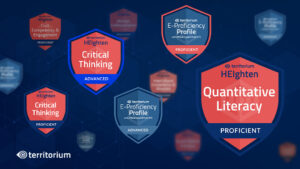Blog
Our latest insights on education, assessments, and employability.
The Rising Value of Badges and Microcredentials in Education and Employment

In an ever-evolving educational and professional landscape, badges and microcredentials have surged to the forefront. These digital credentials are invaluable assets for students, educational institutions, and employers.
Why Badges Matter for Students
- Skill Representation: Badges articulate specific skill mastery.
- Motivation Boost: Recognition enhances learning engagement.
- Career Advancement: Differentiates candidates in job markets.
- Personalized Learning Paths: Showcases individual learning journeys.
- Portable Proof: Facilitates sharing of achievements online.
- Continuous Learning: Encourages ongoing skill enhancement.
- Recognition of Informal Learning: Validates non-traditional learning experiences.
- Goal Setting: Aids in establishing and realizing objectives.
- Flexibility and Accessibility: Offers an adaptable alternative to conventional degrees.
- Community and Network Building: Builds professional and academic connections.
Why Higher Education Institutions Value Badges
- Innovative Image: Positions institutions as forward-thinking.
- Curriculum Enhancement: Complements degrees with nuanced skills.
- Student Attraction and Retention: Appeals to those seeking flexible learning options.
- Partnership Opportunities: Facilitates industry collaborations.
- Data-Driven Insights: Provides actionable learning outcomes data.
- Market Responsiveness: Allows rapid response to market demands.
- Competitive Edge: Offers distinction in a competitive market.
- Lifelong Learning Relationships: Keeps alums engaged with ongoing education.
- Revenue Streams: Opens new financial opportunities.
- Workforce Alignment: Ensures relevance to current industry needs.
The Importance of Badges for Employers
- Skill Verification: Confirms skills quickly and accurately.
- Workforce Development: Promotes upskilling and reskilling.
- Cost Efficiency: More economical than traditional training methods.
- Talent Identification: Simplifies the search for specific skills.
- Professional Growth Tracking: Monitors continuous employee development.
- Job Role Flexibility: Supports versatile employee role assignment.
- Industry Alignment: Closes the gap between current skills and industry requirements.
- Learning Culture: Cultivates an organizational culture of continuous learning.
- Performance Recognition: Acknowledges and incentivizes employee achievements.
- Strategic Partnerships: Leads to beneficial collaborations with educational institutions.
The rise of badges and microcredentials signifies a shift towards more granular, flexible, and skill-specific forms of education and professional recognition. Their impact is tangible for students looking to stand out, for institutions aiming to innovate, and for employers who are prioritizing skill-specific hiring and workforce development. As this trend continues to grow, it’s clear that the ecosystem of learning and professional development is becoming more dynamic and interconnected.
Sign up today for a 15-minute demo of how badges and microcredentials can be integrated into your higher education and workforce strategies.
